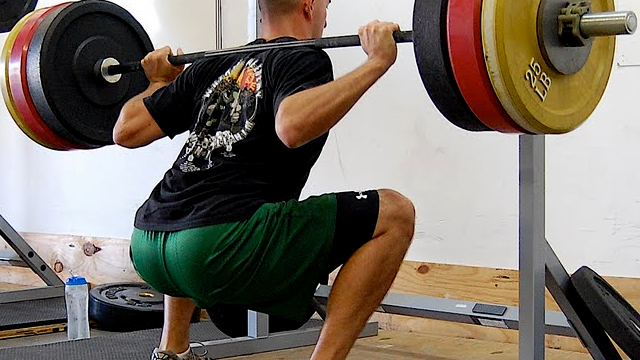In a previous post we talked about how not to do strength and conditioning in a team setting.
In this post I’m going to present some thoughts about strength and conditioning in a team setting. The following are some principles for making athletes stronger in a team strength and conditioning setting:
- Treat strength as a skill
- You can’t do everything
- You won’t do things in the “ideal” order
- You only have time for three sets
- Use the racks, platforms and space to their utmost
Treat strength as a skill:
I have said this a lot on Twitter and in these posts. Maximal strength should be viewed as a skill by strength and conditioning coaches. To be good at a skill you have to practice it often. To have athletes improve their maximal strength, they need to practice it frequently. It’s my preference to work on this once a week (think about undulating periodization here). The intensity may range from 80% and up, but everyone understands that one day a week we are going heavier than the other days.
You can’t do everything:
In most team settings athletes have to show up, dress out, get warmed up, train, and then move on to whatever is next. Athletes don’t have time for 60-120 minute strength and conditioning sessions and in many settings there are restrictions on the amount of time that athletes can be coached. This means that you don’t have time to do everything, exercises have to be prioritized so that you get the biggest return for the athlete’s limited time. For me, a maximal strength training session should focus around a squat, a pull from the floor/hip extension, a press, and a row. If there is time add a shoulder press as well. That’s pretty much all that most athletes will have time for!
You won’t do things in the “ideal” order:
Let’s take the exercises I listed above: a squat, a pull from the floor/hip extension, a press, and a row. That’s also the ideal order for performing those exercises. Here’s the problem, when we have 20-100 athletes training at one time we may not be able to do that or there will be a lot of standing around. While it isn’t ideal, it is okay because it is better than not training!
You only have time for three sets:
If I’m training myself in my garage, I might take the time to do 5-10 sets an exercise, especially for a major exercise like a squat or deadlift. But you can’t do that in a team strength and conditioning setting for two reasons; first there’s too many athletes and never enough equipment. Second, there’s never enough time. This often means getting the athletes warmed up, having some fast warm up sets, and then only having time for three working sets on each exercise.
Use the racks, platforms and space to their upmost:
A few thoughts here. First, you need a system that allows athletes to move smoothly between doing the exercise and not. In other words, one athlete needs to be lifting while others have a role whether it is spotting or loading. Athletes should never be standing around with nothing to do!
Second, space needs to be maximized. If you have racks and platforms then use both at the same time. One group of athletes can be squatting, one can be using the platforms, others can be doing dumbbell or kettlebell exercises.
Third, time needs to be maximized. Group athletes by strength levels. The last thing you want is one athlete lifting 225 on an exercise and then having to take the time to load the bar so that the next athlete can lift 405.
Finally, have a system for the flow. Not just the flow during the exercise but the flow from one exercise to the other. After a few sessions athletes will learn the expectations and it will run itself, allowing you time to actually coach!
In an ideal world, if we want to improve our athletes’ strength levels we would approach things like powerlifters or Olympic lifters. Both approaches work! However, most coaches don’t live in that world and have to take reality into account. Maximize the time you have, prioritize your exercises (you can’t do everything), maximize your space, be organized to the nth degree, and keep everyone busy. If you do these things then you’ll have a pretty successful program!
Revised June 23, 2024



